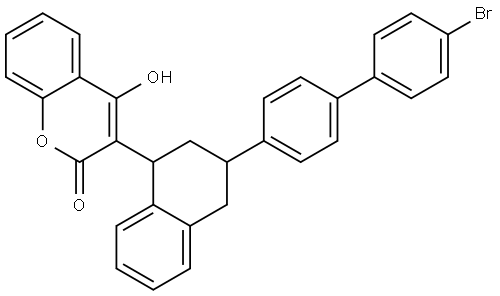Description
Brodifacoum is a 4-hydroxycoumarin anticoagulant that acts as
a vitamin K antagonist. It was registered as a pesticide in 1979
in the United States although in 2008 it was made a restricted
use pesticide by the Environmental Protection Agency. This
means it can only be used by certified pesticide applicators;
however, the makers of D-Con which contains 0.005% brodifacoum
by weight have challenged this and brodifacoum is
currently available in D-Con and in various other pesticide
products for the eradication of mice and rats although it is also
used on larger mammals such as possums. Brodifacoum
currently remains available to the general public.
Chemical Properties
White Solid
Uses
Brodifacoum is a highly lethal vitamin K antagonist anticoagulant poison. In recent years, Broadifacoum, has become one of the world's most widely used pesticides.
Uses
Brodifacoum is used to control rodents in and around buildings.
Definition
ChEBI: Brodifacoum is a member of benzenes, a ring assembly and a member of naphthalenes.
Hazard
Poison, anticoagulant.
Environmental Fate
Brodifacoum, like other hydroxycoumarins, interferes with the
production of vitamin K–dependent coagulation factors.
Vitamin K is a cofactor for the carboxylation of specific glutamic
acid groups in coagulation factors II (prothrombin), VII,
IX, and X. During this step, vitamin K is oxidized to vitamin K
2,3-epoxide. The regeneration of vitamin K by vitamin K
2,3-epoxide reductase is prevented by brodifacoum. As a result,
dysfunctional decarboxy-coagulation factors are produced and
coagulation is impaired. Brodifacoum is over 100 times more
potent than warfarin on a molar basis in rats.
Metabolic pathway
The fate of brodifacoum in soils and plants has not been studied in detail
because the compound is usually applied as a pelleted bait or in a wax
block. This limits its dissipation in the environment. Studies in animals
have been conducted as part of the assessment of safety and to investigate
mode of action.
Degradation
Brodifacoum is a stable compound; no detectable degradation occurs at
50 °C or in direct sunlight over 30 days, though it is liable to some photodecomposition
in solution.
Toxicity evaluation
Brodifacoum has a very low solubility in water and typically
enters water through erosion where it is then found in the
sediment. Brodifacoum concentrations are typically not
measurable in water systems.
Products that contain brodifacoum as pesticide can remain
toxic for a long period of time in the environment. The rate of
decay of brodifacoum depends upon the amount of rainfall. As
the product that contains brodifacoum degrades over time, the
brodifacoum is absorbed into the soil. Soil bacteria degrade
brodifacoum over weeks to months although soil type,
temperature, and the presence of microorganisms that will
degrade brodifacoum all influence the time it takes to degrade.



